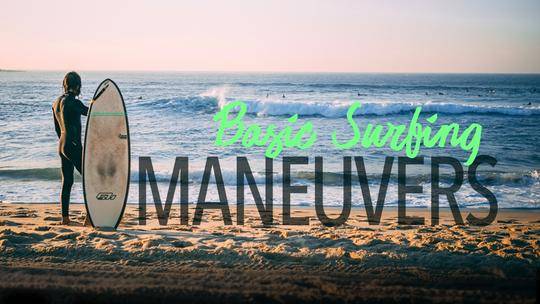When first learning to surf, it may seem like a good idea that you should grab a board and paddle out into the waves, attempting to learn-as-you-go. Unfortunately, you’d be putting not only yourself but other surfers at risk of serious injury by just diving into the first wave you find. That’s why it’s important not only to learn but also know how to learn about basic surfing maneuvers.
The most important thing you can do is take a lesson from a certified instructor. Their experience, knowledge, and ability to facilitate your learning is crucial to ensuring a safe first ride. For everyone’s sake, get an hour or two of lessons.
SO WHAT WILL YOU LEARN?
Here are a few basic maneuvers you’ll need to learn before hitting the waves.
THE POP-UP
This is a criticalmove that takes you from prone to standing in less than a few seconds. Knowing the proper technique will take you from beginner to novice in no time. An instructor can show you how to do this on land. You’ll have the board placed flat on the sand, be shown where your feet should be, and learn how to get them under your body quickly and efficiently.
Paddling into the waves in what gets you from flopping onto your face to riding your first wave. Still, on the sand, an instructor can show you how to make long, smooth, powerful strokes that make you one with the wave.
Getting through the surf is often a struggle for new surfers. Likely, you’ll be learning to surf on a longboard because they are easier to stand up on and learn how to balance on. The downside is that longboards can be tricky to get through the breaking waves and out past the break line where you can finally catch a wave. There are a few favorite ways to accomplish this task.
THE TURTLE ROLL
This is used when paddling straight at a breaking wave. Before the wave hits you, you invert yourself and your board so that the wave can roll over the top of the bottom of your board while you are underwater. Your legs should be dangling and spread apart while you sturdy grip the board. After the wave passesover you, you flip yourself and the board back over.
THE DUCK DIVE
This is used with smaller boards that can be quickly pushed beneath a wave, unlike a longboard. To perform this maneuver, paddle hard a few times before attempting the duck dive to build speed toward the incoming tide. Grab the rails near the front of the board and push it down as deep as you can. Allow your body to follow the board once it’s as deep as you can drive it down.
After your body descends into the water, your knee should push the tail down. One foot should remain behind you, a bit like a scorpion tail. The wave should pass over top of you. After it does, pull the nose of the board back up so you can begin your ascent to the surface. If you dove down particularly deep, a frog kick with your legs could help get back to the surface more quickly.
READY TO SURF?
Now that you know how to get through the breaking waves, paddle into position, and pop-up on the board, you should be ready to attempt your first wave.
Remember, with these basic moves in your arsenal, you’ll be prepared to surf, but always surf with a friend or nearby others for safety reasons. Most importantly, have fun, be kind, and keep your eyes open for other surfers in the lineup!











